The infant will play near the hole of the cobra, and the young child will put his hand into the viper’s nest.
– Isaiah 11:8If your ladder is not leaning against the right wall, every step you take gets you to the wrong place faster.1
– Stephen R. Covey
[1] Though Covey is not thinking eschatologically, the second of his “Seven Habits of Highly Effective People” expresses eschatological truth. Habit number two is: begin with the end in mind. I like how simple, directive, and no-nonsense Covey can be. You should, according to this practice, “begin each day, task, or project with a clear vision of your desired direction and destination, and then continue by flexing your proactive muscles to make things happen.”2
[2] The habits of Christian hope do something similar. As John Webster observes, in hope we are to extend ourselves toward that which is promised, “acting in and upon the world as the reality which it will be,” “seek[ing] the fullest possible anticipation of our end.”3 In other words, we are to flex our proactive muscles according to the vision of the eschaton. It is important to note, however, the crucial difference between hope and habit. The eschatological goal of Christian hope – the completion of God’s saving work in a new creation – is given as a promise, while the goal of the Coveyian habit is self-given – whatever one envisions it to be.
[3] What eschatological goal do you have in mind — the kingdom of God, the beatific vision, participating in the divine nature (2 Pet. 1:4)? For years I have been drawn to the freakish peace described in Isaiah 11:1-9, especially in verse 8. “The infant will play near the hole of the cobra, and the young child will put his hand into the viper’s nest.” It is not that there will be no more hooded snakes in the world to come. On the contrary, Isaiah imagines that we will live together as companions in a new way. God has used the sheer extremity of this vision to create a desire and expectation in me for such a wondrous and pervasive kind of peace.
[4] On a recent trip to Kakuma Refugee Camp in northern Kenya, I imagined another eschatological goal to keep in mind, a variation on the cuddling with cobras theme. After hearing from the residents and staff of the camp about the scorpion infestation, I was afraid of being stung. At night, whenever the mosquito net hanging over me would barely brush against my shoulder or leg, I was sure that it was a scorpion coming after me. I could not get that Die Another Day scene out of my head when James Bond was captured and thrown into a cell full of hundreds of them.4 Agent 007 regularly received an antidote only after he had been stung all over, so that he could die another day. The eschatological goal I now have in mind is lying in a bed of scorpions, tickled somewhat maybe, but content.
[5] So, what does hope in a future like this have to do with the present? Such a goal suggests to me a kind of peace worth praying for and working toward today: a peace between people whose differences are otherwise perceived as at best tolerable and at worst threatening, the differences between me/you/us and the other (the neighbor, the stranger, the enemy). On the continuity between today and the eschatological tomorrow, Webster writes,
Christian hope does not look only for the overthrow of present disorder, but also for the vindication of present righteousness…. The manifestation to which hope looks, and towards which it acts, will also be the vindication of present action — that is, the declaration that such action has been in conformity with the good order of God. To act in the light of that coming vindication is to trust that acts whose end is not yet evident, and which may therefore appear vulnerable, even futile, will bear fruit. Charity which receives little or no reciprocation, resistance to powers which oppose Jesus Christ, sponsoring forms of civic courtesy and respect for strangers: such things are hopeful….5
[6] Finally, we might wonder with Robert Jenson, “how…is the Church to speak her eschatological hope with any public plausibility?”6 How are we supposed to talk about a future where peace looks like an infant playing near the hole of a cobra and a young child putting his hand into a viper’s nest? Jenson proposes that “[t]he assembly of believers must … itself be the event in which we may behold what is to come.”7 He continues: “If, in the postmodern world, a congregation or whatever wants to be ‘relevant,’ its assemblies must be unabashedly events of shared apocalyptic vision. ‘Going to church’ must be a journey to the place where we will behold our destiny, where we will see what is to come of us.”8
[7] If Jenson’s view of the church is idealized, he is nevertheless right about the church’s testimony in speech, sacrament, liturgy, music, art, and architecture on the one hand, and, we should add, its testimony in study, service, advocacy, and resistance on the other. Rich, poetic, narrative, and conceptually-articulate description of who God is, what God does, and the world to come joined with the communal embodiment (however imperfect) of the peace that is promised are ways that we communicate our hope here and now.
Endnotes
1. https://www.stephencovey.com/7habits/7habits-habit2.php.
2. https://www.stephencovey.com/7habits/7habits-habit2.php.
3. John Webster, “Hope,” in The Oxford Handbook of Theological Ethics, eds. Gilbert Meilaender and William Werpehowski (Oxford: Oxford University Press, 2005) 304.
4. Die Another Day (2002) was produced by Michael G. Wilson and Barbara Broccoli, directed by Lee Tamahori, and stars Pierce Brosnan.
5. Webster, 304.
6. Robert Jenson, “How the World Lost Its Story,” republished in First Things (March 2010) 36. This article was first published in the October 1993 of First Things.
7. Ibid., 36.
9. Ibid., 36.


